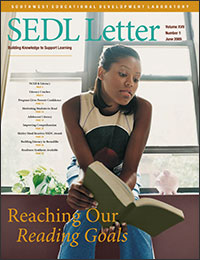Teacher Quality and Reading
The studies cited in the first paragraph of “Literacy Coaches: Roles and Responsibilities” represent a range of studies that emphasize the importance of teacher quality in reading. Here is a brief summary of some of the research cited.
“The Cooperative Research Program in First-Grade Reading Instruction,” by Guy Bond and Robert Dykstra (1967) is landmark research in the field of reading. The Cooperative Research Program included 27 research projects studying first-grade students and designed to gather data relevant to three basic questions:
- To what extent are various pupil, teacher, class, school, and community characteristics related to pupil achievement in first-grade reading and spelling?
- Which of the many approaches to initial reading instruction produces superior reading and spelling achievement at the end of first grade?
- Is any program uniquely effective or ineffective for pupils with high or low readiness for reading?
Each of the 27 projects collected different types of student data including personal information such as age, sex, amount of preschool experience, and the number of days of absence during the experimental period. Other data focused on information about the teacher, the student’s class, the school in which he or she was enrolled, and about the community in which he or she lived. Numerous pre-instructional and postinstructional tests were administered and measures of each student’s writing ability and attitude toward reading were obtained.
Bond and Dykstra’s findings correlated teacher experience with student reading achievement, based on five measures of the Stanford Achievement Test. A rating of general teacher efficacy also correlated positively with the five achievement measures.
Susan Brady’s and Louisa Moats’s position paper for the International Dyslexia Association, “Informed Instruction for Reading Success: Foundations for Teacher Preparation,” drew on 20 years of reading research to identify core requirements for reading teachers. They stress the necessity of teachers’ receiving a solid foundation regarding the “theoretical and scientific underpinnings for understanding literacy development,” including knowledge of the relationship between the spoken and written language, sophisticated understanding of the development of phonological awareness and the process of learning to read, and an understanding of what constitutes adequate research evidence. They also suggest teachers have a strong knowledge of the structure of language including knowledge of the English speech sound system and its production, knowledge of the structure of English orthography and its relationships to sound and meaning, and knowledge of grammatical structure.
Louisa Moats and Barbara Foorman conducted a 4-year descriptive, longitudinal study of reading instruction in low-performing, high-poverty schools that included teacher surveys and observation. The researchers surveyed teachers who taught in grades K–4 to document their understanding of reading instruction and language concepts. They also analyzed the teachers’ misconceptions about sounds, words, sentences, and principles of reading instruction. Moats and Foorman reported that they “established a modest predictive relationship between teachers’ knowledge, classroom reading achievement levels, and teachers’ observed teaching competence.” They also write, “We found surprising gaps in teachers’ insights about learning to read.”
Linda Darling-Hammond used data from a 50-state survey of policies, state case study analyses, the National Center for Educational Statistics’ (NCES) Schools and Staffing surveys, and the National Assessment of Educational Progress (NAEP) to examine ways in which teacher qualifications and other school factors are related to student achievement across states. Quantitative analyses showed measures of teacher preparation and certification as the strongest correlates of student achievement in reading and mathematics, even after controlling for student poverty and language status.
William Sanders and Sandra Horn were among the researchers who analyzed the Tennessee Value-Added Assessment System (TVASS). TVASS is a large database linking students and student outcomes to the schools and districts in which they are enrolled and to the teachers to whom they are assigned from grade to grade. Sanders and Horn reported, “Research conducted from the TVAAS database has shown that race, socioeconomic level, class size, and classroom heterogeneity are poor predictors of student academic growth. Rather the effectiveness of the teacher is the major determinant of student academic progress.”
Catherine Snow and her colleagues Wendy Barnes, Jane Chandler, Irene Goodman, and Lowery Hemphill used a mixture of approaches (interviews, observations, and tests) in their long-term study, which is documented and discussed in Unfulfilled Expectations: Home and School Influences on Literacy. They studied the effects of home and school experiences in the lives of low-income children on their literacy achievement, comparing low-income families that had children who had been successful in school with low-income families that had children who were below-average learners. One of the factors they examined was the performance of students who received instruction from teachers determined to be “strong” teachers versus the performance of students who received instruction from “weak” teachers. The researchers found a correlation between teachers and reading ability. Students who received 2 years of reading instruction from strong, knowledgeable teachers tended to become successful readers no matter how much home support they received. Even students who came from literacy-poor homes where reading and education were not well supported tended to be successful when given 2 years of instruction from knowledgeable, highly qualified teachers.
Next Article: Program Gives Parents Confidence to Bolster Their Kids' Success in Georgia

